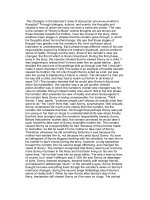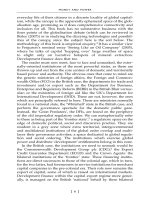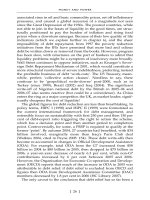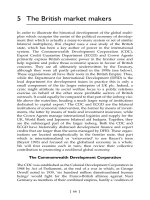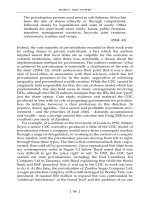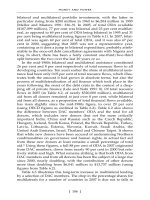Banking reforms in the transitional economy of china
Bạn đang xem bản rút gọn của tài liệu. Xem và tải ngay bản đầy đủ của tài liệu tại đây (670.47 KB, 290 trang )
BANKING REFORMS IN THE
TRANSITIONAL ECONOMY OF CHINA
CONNIE CHUNG WEE - WEE
(B.A., B. Soc. Sci. (Hons.), M. Soc. Sci., NUS)
A THESIS SUBMITTED
FOR THE DEGREE OF PH. D. (ECONOMICS)
DEPARTMENT OF ECONOMICS
NATIONAL UNIVERSITY OF SINGAPORE
2005
To my beloved parents
i
ACKNOWLEDGMENTS
I would like to express my sincere appreciation to my supervisor, Associate
Professor Jose L. Tongzon, for his invaluable advice, encouragement and
enthusiasm. He demonstrates empathy and guidance skills through his ongoing
enthusiasm in my work. Professor Tongzon avails himself readily whenever I
need to consult him on issues relating to my areas of research, despite his busy
working schedule. His patience and tenacity are noteworthy. His good listening
skills has helped me to move forward positively in my academic pursuit. We have
an excellent working relationship.
Other positive support came from Associate Professor Tilak Abeysinghe,
Associate Professor Gavin Peebles, Dr. Yu Qiao, fellow peers OG and Enrico,
Diana, the administration staff of the Department of Economics, and the library
personnel of the National University of Singapore and the East Asia Institute. My
inner strength comes from family members and friends, including those from afar,
who believe in the “paradigm shift” that I am embarking on in my life. I am
thankful to them for their outpourings of good wishes and bountiful blessings. I
am, ultimately, eternally grateful to the Most High for His unfailing love, mercy
and grace.
ii
CONTENTS
ACKNOWLEDGEMENTS i
TABLE OF CONTENTS ii
SUMMARY v
LIST OF TABLES viii
LIST OF FIGURES x
LIST OF ACRONYMS xi
TABLE OF CONTENTS
CHAPTER ONE: Banking reforms: policy changes, implementation 1
Issues and implications
1.1 Introduction and motivation of the thesis 1
1.2 Economic performance 8
1.3 1979-1993 15
1.3.1 Assessments and implementation issues 20
1.4 1994-2003 24
1.4.1 Issues and implications 31
1.5 Conclusion 44
CHAPTER TWO: Whither the impact of financial deepening on 48
China’s economic growth 25 years on?
2.1 Introduction and motivation 48
2.2 Financial deepening and economic growth 52
2.3 Data analysis 56
2.3.1 The Chinese financial sector is dominated by the banking system 56
2.3.2 Indicators of financial deepening and economic growth 59
2.4 Empirical test and results 63
2.5 The role of financial deepening in a growing Chinese economy 73
2.5.1 The growing importance of the non-state sector to China’s 73
economic growth
iii
2.5.2 Bias in credit allocation 77
2.5.3 Non-state enterprises “thriving on a tilted playing field” 79
2.5.4 The role of the curb market financing 80
2.5.5 Growth is driven by China’s high savings rates 82
2.5.6 Role of the central bank in mitigating the negative effects 83
of growth in indirect financing
2.6 Conclusion 85
CHAPTER THREE: Evaluating the efficiency of Chinese banks: 87
a non-parametric approach
3.1 Introduction and motivation 87
3.2 Literature review 90
3.3 DEA methodology 96
3.4 Data Analysis 106
3.4.1 The sample banks 107
3.4.2 The intermediation approach 115
3.4.3 The choice of input and output variables 116
3.5 Empirical results 120
3.5.1 Evaluating the efficiency of the sample of Chinese banks 121
3.5.2 Evaluating the efficiency of the banking segments 126
3.5.3 Percentage reduction in input usage recommended for the 133
inefficient banks
3.6 Conclusion 140
CHAPTER FOUR: A paradigm shift for China’s central banking system 146
4.1 Introduction and motivation 146
4.2 Literature review 149
4.3 Monetary policy management 152
4.4 Is the PBC an independent central bank? 159
4.4.1 Political and policy independence 161
4.4.1.1 Leadership appointments 162
4.4.1.2 Boardroom decision-making process 163
4.4.1.3 Resistance at the grassroots level 165
4.4.1.4 Role in policy lending 167
4.4.2 Financial independence 170
4.4.3 The relationship between the government and the party 170
4.5 A paradigm shift for the PBC 174
4.6 Conclusion 180
iv
CHAPTER FIVE: Confronting the new Chinese banking environment 183
post-WTO: implications and strategies
5.1 Introduction and literature survey 183
5.2 Analytics of financial liberalization 189
5.3 Implications of WTO’s accession on domestic banking 191
5.4 Strategies to counter competition 196
5.4.1 Capitalize on current strength 196
5.4.2 Diversify product and service offerings 197
5.4.3 Market repositioning-target segmentation 203
5.4.4 Restructuring 203
5.4.5 M&A and alliance strategies 207
5.4.6 Organizational transformations 212
5.5 The new Chinese banking environment post-WTO 215
5.6 Concluding remarks 220
CHAPTER SIX: Conclusion: Does China’s banking system still have 222
a long way to go?
6.1 The China approach 222
6.2 Banking reforms at the “new” crossroads 225
6.3 The contributions of my thesis 232
BIBLIOGRAPHY 236
APPENDIX 264
I. Chronology of Foreign Banking Reforms 264
II. DEA Results 273
v
SUMMARY
The banking reforms in China have played an instrumental role in the country’s
overall effort to transform a centrally-planned economy into a market-driven
economy. The thesis examines the changes that took place in the banking system
from 1979 to 2003. It attempts to address four main areas when analyzing the
banking industry during this period.
Firstly, the thesis finds answers to some important policy-related questions
concerning the impact of banking industry development on China’s overall
economic growth. The Granger-causality empirical outcomes reveal that banking
industry development helps explain its economic growth in the reform era. There
is a “supply-leading” causality relationship between two financial deepening
indicators, that is, real M1 to real GDP growth, and real M2 to real GDP growth,
and the economic growth indicator, that is, real GDP growth. With the exception
of real quasi-money to real GDP growth, the empirical test also demonstrates a
similar “supply-leading” causal relationship between all the other financial
deepening indicators and real fixed assets investments growth. The study
concludes that the more productive non-state sector should not be overlooked in
the financial deepening process as it will be the new engine of growth for China
in the foreseeable future. It recognizes, however, that the primary shortcoming of
this empirical test is that it completely ignores the role of curb market financing in
non-state sector development.
vi
Secondly, the relative technical and scale efficiencies of a sample of Chinese
banks are analyzed using a non-parametric technique, called Data Envelopment
Analysis (DEA). This technique allows the identification of both the “relatively”
efficient and inefficient banks. Recommendations are made to all the inefficient
banks to implement percentage reductions of their various input usage areas so as
to attain full efficiency or move to the “efficient frontier”. The results also allow
management to revisit the way resources are currently utilized and better plan for
their organizations’ future.
Thirdly, in analyzing the effectiveness of the central bank, the People’s Bank of
China (PBC), as a monetary policy manager, financial supervisor and regulator,
the thesis concludes that it has only gained some operational independence and
not complete independence as China’s central banker. As China progressively
opens to the rest of the world, it is timely that the PBC revisits its roles and
functions and makes a quantum leap to genuine central bank management, as
practiced in market economies.
Finally, in assessing the implications of China’s accession to the World Trade
Organization (WTO) on domestic banking, the thesis highlights that the banks
need to embark on six major strategies to counter the increasing competition
amongst themselves as well as from their foreign counterparts. The new banking
landscape ultimately will still be shaped by China’s trade and investment
liberalization and overall economic reform program.
vii
It is apt that the thesis concludes with a pragmatic analysis of the many challenges
that a post-WTO environment would bring about, with China’s banking industry
moving on to a higher plane, and the banking reforms starting on a new journey in
this new millennium.
viii
LIST OF TABLES
Table 1.1: Economic performance (per cent) 10
Table 1.2: Market share in major export markets 12
(imports from China divided by total imports, in per cent)
Table 1.3: Sources of imports (as a percent of China’s total imports) 12
Table 1.4: The ten largest holders of foreign exchange reserves in 2003 13
(USD million)
Table 1.5: Social indicators (per cent) 14
Table 1.6: Interest rates (5-year average) 18
Table 1.7: Comparisons of interest rate spreads 18
Table 1.8: Summary of closure of financial institutions in China 31
Table 1.9: Subsidies to loss-making state-owned enterprises 33
Table 1.10: Market Shares of Financial Institutions, September 2003 35
(in percent of total)
Table 1.11: Non-performing loans based on the five-tier classification system 37
Table 1.12: Comparison of China’s gross domestic savings with other countries’ 39
Table 2.1: Sources of funds in 2003 58
Table 2.2: Monetary Depth and Financial Intermediation Ratio 61
Table 2.3: Time series properties of the variables 69
– Augmented Dickey-Fuller (ADF) statistics
Table 2.4: Pairwise Granger Causality tests between financial deepening 71
and economic growth indicators
Table 2.5: Statistics on China’s GDP, Fixed Assets Investments and 75
Gross Industrial Output (RMB 100 million)
Table 2.6: Share of industrial output by the state sector and 76
non-state sector (per cent)
ix
Table 2.7: Share of non-agricultural employment by the state sector and 77
non-state sector (per cent)
Table 2.8: Distribution of total investments in fixed assets by sector (per cent) 79
Table 2.9: Comparison of loan-to-deposit ratios of state banks: 83
Henan, Fujian, and Zhejiang, 1988-1999
Table 3.1: The four banking segments and their respective banks used 113
in the sample
Table 3.2: Descriptive summary statistics on the input and output data, 2002 118
(RMB million)
Table 3.3: Descriptive statistics on the efficiency measures of the sample 122
of banks
Table 3.4: Spearman’s Rank Correlation Analysis 125
Table 3.5: Descriptive statistics on the efficiency measures of the 127
banking segments
Table 3.6: Percentage reduction in input usage recommended for inefficient 138
banks (organized by banking segments) - per cent
Table 4.1: Policy loans (RMB billion) 168
Table 5.1: Foreign investments in domestic banks and financial institutions 209
x
LIST OF FIGURES
Figure 1.1: Comprehensive Banking System 28
Figure 2.1: Times series 66
Figure 3.1: Piece-wise Linear Convex Unit Isoquant 98
Figure 3.2: Pure Technical and Scale Efficiency 106
Figure 3.3: Asset Profile of the Banks 114
Figure 3.4: Net Income Profile of the Banks 114
xi
LIST OF ACRONYMS
ADF Augmented Dickey-Fuller
AIC Akaike Information Criterion
ATM Automated-teller-machine
BCC Banker, Charnes and Cooper
BOCHK Bank of China (Hong Kong) Ltd.
CCP Chinese Communist Party
CCR Charnes, Cooper and Rhodes
CFWC Central Financial Work Committee
Citibank Citibank NA
CRS Constant returns-to-scale
DEA Data Envelopment Analysis
DMUs Decision-making units
FDI Foreign direct investment
GDP Gross domestic product
GNP Gross national product
HKD Hong Kong dollars
HSBC Hong Kong and Shanghai Banking Corporation
M&A Merger and acquisition
MPC Monetary Policy Committee
M1 Sum of currency and demand deposits
M2 Broad money supply
PBC People’s Bank of China
xii
PTE Pure technical efficiency
RMB Renminbi
SE Scale efficiency
SEZ Special Economic Zone
Standchart Standard Chartered Bank
SPC State Planning Commission
SFA Stochastic frontier approach
TE Overall technical efficiency
USD United States of America dollars
VRS Variable returns-to-scale
WTO World Trade Organization
CHAPTER ONE
Banking reforms: policy changes, implementation issues and implications
1.1 Introduction and motivation of the thesis
China has had a varied and “progressive” experience in the banking arena from
the time of the Qing Dynasty (1644-1911); to the founding of the Republic of
China (ROC), by Dr. Sun Yat-Sen on 1
st
January 1912; the Communist takeover
and founding of the People’s Republic of China (PRC) in 1949, led by Chairman
Mao Ze-Dong; the Cultural Revolution era (1966-1976); the Deng Xiao-Ping era
with major economic reforms implemented from 1978; and to the present day
when it faces challenges that comes with globalization and the advent of the New
Economy (Samansky, 1981; Byrd, 1983; World Bank, 1990; Dipchand et al.,
1994; Gang, 1994; Tam, 1995; Wan, 1999; Cheng, 2003).
Banking reforms have played an important role in China’s overall effort to
transform a centrally-planned economy into a market-based economy. The
banking system, however, faces many challenges as it is being transformed into a
modern system, emulating those in a capitalistic world. While it boasts of state
banks that are huge even by international standards, that is, by assets, the banking
system’s fragility has led to many debates among the academia, and the private
and public sectors alike, on the possibility of it triggering off a financial crisis. Its
2
transformation has been much hampered by the weaknesses and inertia reforms of
the enterprise, social security, and the budgetary systems (Lardy, 1998b; Xu,
1998; Dornbusch and Giavazzi, 1999).
The thesis has four main objectives. It seeks to do the following:
1. address some important policy-related questions concerning the impact of
banking industry development on China’s overall economic growth during
the reform era,
2. analyze the relative efficiencies of the financial intermediaries,
3. analyze the effectiveness of the central bank, that is, the People’s Bank of
China (PBC) as a monetary policy manager, financial supervisor and
regulator, and
4. assess the implications of China’s accession to the World Trade
Organization (WTO) on domestic banking, and analyze the major
strategies that these banks could embark on to counter the problems that
may impair their competitiveness in a post-WTO setting.
CHAPTER TWO of the thesis, entitled “Whither the impact of financial
deepening on China’s economic growth 25 years on?” seeks to address the
following questions regarding the development of the banking industry. These
include the following:
- how was the state of financial intermediation in the initial 25 years
of reform?
3
- does the development of the banking industry help to explain
China’s economic growth during the reform era and vice versa?
- have both the state and non-state sectors benefited equally from the
development of the banking industry?, and
- does financial intermediation include the role of informal finance
or curb market financing in private sector development?
In CHAPTER THREE, a non-parametric technique called the Data Envelopment
Analysis (DEA) is used to analyze the relative efficiencies of the Chinese
financial intermediaries. The study compares a sample of major banks and
attempts to answer the following questions:
- what are the relative technical and scale efficiencies of these
banks?
- how do the banking segments perform, such as the state-owned
commercial banks, other national commercial banks, regional
banks, and city commercial banks?
- what account for their inefficiencies?, and
- what areas of operations can they improve upon?
CHAPTER FOUR, entitled “A paradigm shift for China’s central banking
system” seeks to provide answers to the following questions regarding the role of
the central bank:
4
- what leadership role does the PBC play in China’s central
banking?
- how effective is the PBC in executing its roles as a monetary
policy manager, financial supervisor and regulator?
- how does the PBC manage its relationship with the central
government, the party, the local governments, state-owned
enterprises and the financial institutions?, and
- how do the current organizational and operational mechanisms
play a positive role in the banking industry? do they exacerbate the
problems already faced by the industry?
The implications of China’s accession to WTO on domestic banking are analyzed
in CHAPTER FIVE, which is entitled “Confronting the new Chinese banking
environment post-WTO: implications and strategies”. The following key
questions are discussed:
- what are the strategies that the domestic banks need to work on to
counter the increasing competition amongst themselves as well as
from their foreign counterparts?
- will the intense competition from the foreign banks result in
reduced profitability, market shares and “brain drain” of business
and critical staff? or will the new climate also offers new revenue-
generating business opportunities, and innovative and quality
products and services?
5
- how will the new Chinese banking marketplace look like in a post-
WTO era?, and
- will the new banking landscape ultimately still be shaped by
China’s trade and investment liberalization and overall economic
reform program?
The concluding chapter, that is, CHAPTER SIX, revisits the approach undertaken
by the government in reforming the banking industry so as to get a clearer picture
of where it is heading to, in the near future. This is especially so when the
industry is now at a “new” crossroads after having experienced two and a half
decades of transformation.
While major banking reforms in China were not implemented until early 1990s
(Ariff and Khalid, 2005), this introductory chapter examines the changes that took
place in the banking system since 1979. The period for analysis is further divided
into two phases, namely, 1979-1993, and 1994-2003. In each phase, policy
changes were scrutinized and their implementation issues highlighted. Although
the reforms that took place during the 1979-1993 period were significant, as the
Chinese economy emerged from the recent “Cultural Revolution” setting to a
market economy, their implementations had some impact but were too slow.
However, they were part of the broader financial reforms which aimed to
mobilize savings, facilitate a more efficient allocation of credit and promote
macroeconomic stability. Ultimately the objective was to raise China’s economic
6
performance. The restoration of the independence of the central bank, the PBC,
was an important reform that took place. This claim of the PBC’s “independence”
stature was, however, widely criticized as it was seen manifesting operational
independence and not complete independence. A discussion on its lack of
independence is found in CHAPTER FOUR of this thesis, “A paradigm shift for
China’s central banking system” (pp. 146-182). Other banking developments
included the creation of a formal banking structure and state banks with their own
economic niche roles; the increase in savings or investment channels for the
individuals and enterprises; the development of a wide variety of financial
instruments, and the establishment of money and capital markets.
The period 1994-2003 saw the pressing need for urgent economic reforms as the
country faced pressing battles with slowing economic growth figures. The growth
rate of GDP declined from 12.6 per cent in 1994 to 7.1 per cent in 1999 before it
rose to 8.0 per cent in 2000, 8.3 per cent in 2002, and 9.3 per cent in 2003 (see
Table 1.1). As part of the government’s comprehensive economic program
announced in 1994, the banking industry was to be developed further to facilitate
both the development of the overall financial sector as well as effective monetary
policy operations. In the later years much of the government’s focus were devoted
to recapitalizing the pillar state banks which faced high non-performing loans and
were insolvent, the empowering of the central bank in its supervisory and
regulatory roles, and the accession of China into the WTO.
7
This chapter provides adequate background knowledge on China’s endeavors in
reforming its banking industry, so as to allow better understanding of the other
areas of analysis in the subsequent chapters of the thesis. In all, the thesis meets
its objectives of effectively scrutinizing the layers below the “ice-berg” of
banking reforms in China through its boldness in making a “gradualistic” leap
from a “command-driven” banking system to a “market-driven” one, embedded
with “Chinese characteristics”, and in the process changing the face of the
Chinese financial landscape.
This chapter is organized as follows. Section 1.2 discusses China’s economic
performance, while the policy changes, issues and implications of the banking
reforms during the two periods are explored in Sections 1.3 and 1.4 respectively.
Section 1.5 concludes.
8
1.2 Economic performance
The Chinese economy has achieved spectacular performance since 1979, with its
GDP growing at an average rate of 10.3 per cent during 1980-1990 and 9.6 per
cent during 1990-2003 (World Development Indicators, 2005). In 1978, China’s
total GDP was only USD44 billion. However, by mid-2000 its total nominal GNP
had reached USD1 trillion (Wong, 2003). China’s GDP per capita had also
steadily moved up from USD167.6 in 1980 (Dutta, 2006) to USD963 in 2002
(World Development Indicators, 2005).
Table 1.1 and Table 1.5 highlight the economic and social performance of the
Chinese economy during the period 1979-2004. In the last five years, its GDP has
consistently achieved growth rates of between 7.5 per cent and 9.5 per cent. While
its agricultural sector’s share of GDP has declined from 31.17 per cent in 1979 to
13.11 per cent in 2004, the services sector’s share of GDP has increased from
21.44 per cent in 1979 to 40.67 in 2004. The industry sector’s share of GDP has
been consistent since 1979, averaging 45 per cent. In fact the growth rate of this
sector fell to 11.1 per cent in 2004 from 12.7 per cent in 2003 (Asian
Development Outlook, 2005).
There was an increase in the growth rate of domestic savings to GDP in particular
after 1994, averaging 40 per cent. Ariff and Khalid (2005) reiterated that this was
largely due to the reforms that were initiated during the 1991-95 period. Fixed
9
capital formation to GDP has shown a gradual increase between 1979 and 2004,
although there was an approximate 10 per cent increment over this period.
Between 1979 and 2004 China has experienced both inflationary and deflationary
pressures. There were two episodes of high inflation which exceeded 10 per cent.
These occurred in 1988-1989 and 1993-1995 (Woo, 2003). The change in
consumer prices was 18.33 per cent in 1989 and 24.1 per cent in 1994. Beginning
in 1995, the inflationary pressure started to decline and meanwhile the growth rate
of GDP declined from 9.6 per cent in 1996 to 8.8 per cent in 1997, 7.8 per cent in
1998, and 7.1 per cent in 1999 before it rose to 8.0 per cent in 2000. The PBC has
experimented with both direct and indirect controls to manage money supply
during these inflationary and deflationary periods. The share of money supply to
GDP has grown tremendously from 27.46 per cent in 1979 to 150.14 per cent in
2004. Its growth rate in 2004, however, fell to 14.6 per cent from 19.6 per cent in
2003 (Asian Development Outlook, 2005).
10
Table 1.1: Economic performance (per cent)
Economic indicators
1979 1984 1989 1994 1999 2000 2001 2002 2003 2004
GDP growth
7.6 15.2 4.1 12.6 7.1 8.0 7.5 8.3 9.3 9.5
Sectoral shares of GDP, Value
Added (%)
- Agriculture
- Industry
- Services
31.17
47.38
21.44
32.01
43.31
24.68
25.0
43.04
31.95
19.65
46.57
33.78
16.22
45.76
38.02
14.83
45.91
39.25
14.14
45.15
40.69
13.49
44.79
41.72
12.56
45.97
41.46
13.11
46.22
40.67
Gross domestic savings/GDP
35.58 34.37 35.02 42.2 39.4 38 38.6 38.7 47.00 47.00
Gross fixed capital
formation/GDP
28.51 29.64 25.66 34.97 32.87 32.88 33.57 34.84 37.73 38.38
Inflation
- - 18.33 24.1 -1.4 0.4 0.7 -0.8 1.2 3.9
M2/GDP
27.46 44.01 62.08 85.69 126.34 129.52 133.31 142.61 151.06 150.14
Trade/GDP
18.07 22.73 34.42 47.31 37.97 44.24 43.08 47.70 56.91 65.35
Current account balance/GDP
- 0.79 -1.26 1.30 1.60 1.9 1.5 2.8 3.2 3.3
Foreign direct investments, net
inflows /GDP
0.0 0.49 0.99 6.23 3.91 3.55 3.76 3.89 3.26 2.84
Sources: Asian Development Outlook (various issues), World Development Indicators (various issues)
11
China’s international trade has expanded steadily with its overall share in world
trade rising from less than 1 per cent in 1979 to about 6 per cent in 2003 (Prasad
and Rumbaugh, 2004). With the relaxation of import and export controls in the
1980s and the implementation of broader trade reforms in the 1990s, China’s
trade contribution to GDP has increased 3.6 times, that is, from 18.07 per cent in
1979 to 65.35 per cent in 2004. Both imports and exports have increased rapidly.
It attained a current account surplus of 3.3 per cent of GDP in 2004.
China now serves as the final processing and assembly platform for a large
quantity of imports from other Asian countries, in particular, which are to be
exported to western countries. Table 1.2 shows its growing market shares in major
export markets in the developed nations such as Japan, the United States of
America and the European Union. In 1980 it held a 3.1 per cent, 0.5 per cent and
0.7 per cent market shares in Japan, the United States of America and the
European Union, respectively. However, by 2003 this has increased to 18.5 per
cent, 12.5 per cent and 8.9 per cent in these countries, respectively. At the same
time, the Chinese economy’s role in Asian regional trade has also become
increasingly important. It is now among the most important export destinations
for other Asian countries such as the ASEAN (Association of South East Asian
Nations), Japan, South Korea, and Taiwan, as illustrated in Table 1.3. The Asian
countries’ share of imports increased from 15.0 per cent in 1980 to 52.8 per cent
in 2003, slightly more than half of all China’s total imports.
